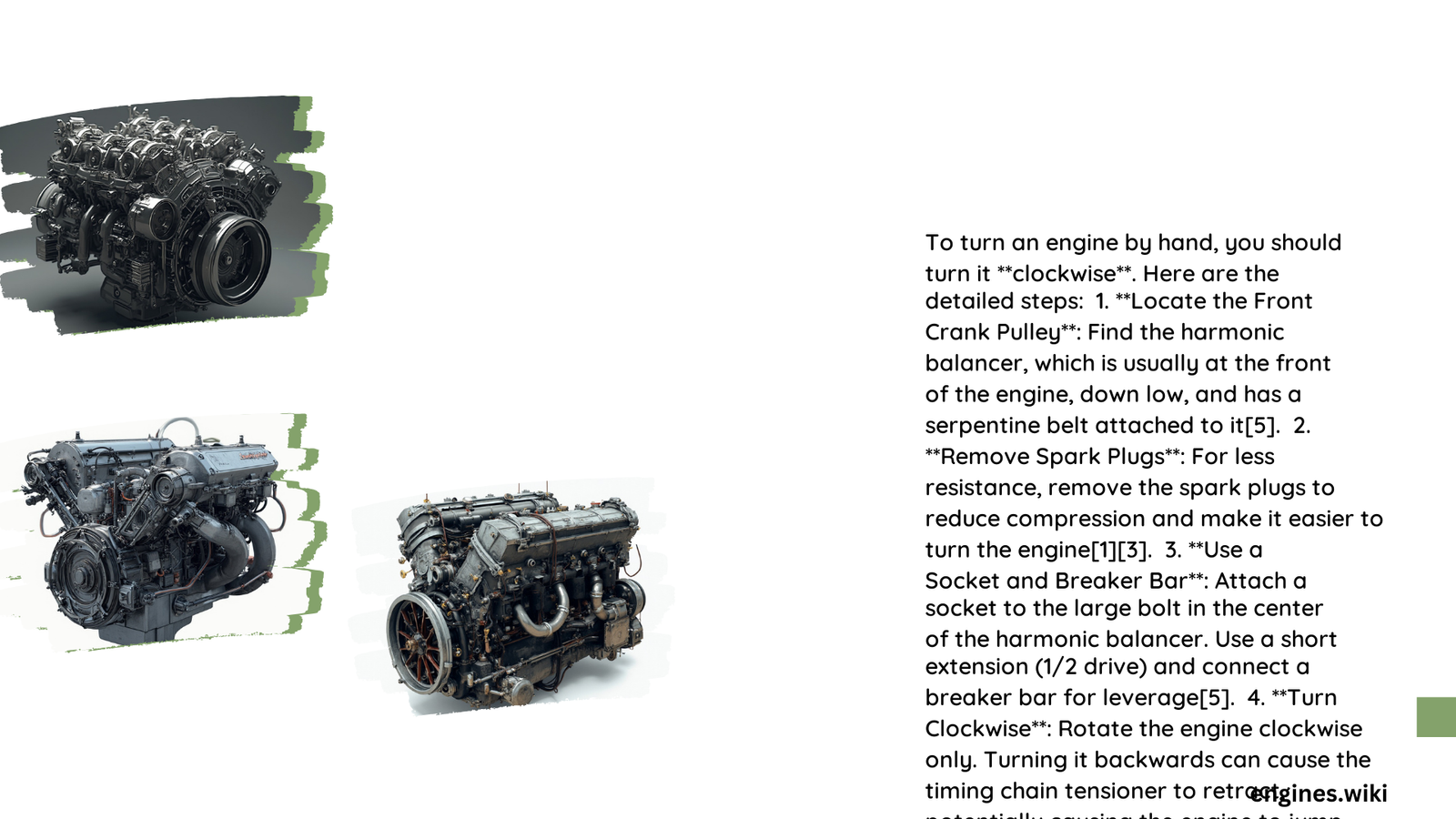When manually rotating an engine, it’s crucial to turn the crankshaft in the correct direction to avoid damaging internal components. For most engines, the correct direction is clockwise when facing the front of the engine. However, exceptions exist, and it’s essential to verify the specific requirements for your engine model. This guide will explore the correct methods, tools, and precautions for hand-turning various engine types.
What is the Correct Direction to Turn an Engine by Hand?
The majority of engines are designed to rotate clockwise when viewed from the front (harmonic balancer side). This standard applies to most automotive engines, including popular makes like Toyota, Ford, and Chevrolet. However, it’s important to note that some engines, particularly certain Honda models, may have different rotation directions.
Why is the Correct Rotation Direction Important?
Turning the engine in the wrong direction can lead to several issues:
- Timing chain damage
- Valve interference
- Potential piston-to-valve contact
- Disruption of oil circulation patterns
To avoid these problems, always confirm the correct rotation direction for your specific engine model before attempting to turn it by hand.
What Tools are Needed to Turn an Engine by Hand?

To safely and effectively turn an engine by hand, you’ll need the following tools:
- Long breaker bar (at least 18 inches)
- Appropriate size socket for the crankshaft bolt
- Torque wrench (for reassembly)
- Spark plug socket and ratchet (for removing spark plugs)
| Tool | Purpose |
|---|---|
| Breaker bar | Provides leverage for turning the crankshaft |
| Socket | Fits onto the crankshaft bolt |
| Torque wrench | Ensures proper tightening of bolts during reassembly |
| Spark plug socket | Allows for spark plug removal to reduce compression resistance |
How to Turn Specific Engine Models by Hand?
Different engine models may have unique requirements for manual rotation. Let’s explore some common examples:
Toyota 22R Engine
- Direction: Clockwise when facing the harmonic balancer
- Tools: 18-inch (or longer) 1/2″ drive breaker bar
- Socket size: 19mm for the crank pulley bolt
Mercedes-Benz 280 SE 4.5
- Direction: Clockwise when facing the front of the engine
- Tools: Breaker bar and appropriate socket for crank pulley
- Tip: Remove spark plugs to reduce compression resistance
D239 Engine
- Direction: Counter-clockwise as viewed from the flywheel (typically clockwise from the front)
- Caution: Verify direction based on specific engine configuration
What Safety Precautions Should be Taken When Turning an Engine by Hand?
When manually rotating an engine, consider the following safety measures:
- Disconnect the battery to prevent accidental starting
- Remove all drive belts to reduce resistance
- Ensure the transmission is in neutral
- Use proper lifting techniques to avoid injury
- Wear safety glasses and gloves
How Does Engine Condition Affect Manual Rotation?
The condition of the engine can significantly impact the ease of manual rotation:
- Long-term storage: May lead to stuck valves or piston rings
- Corrosion: Can cause components to seize
- Uneven compression: Makes rotation more difficult
- Oil condition: Lack of lubrication increases friction
To address these issues:
- Apply penetrating oil to cylinder walls
- Remove spark plugs to reduce compression resistance
- Gently rock the engine back and forth before full rotation
What are Common Mistakes to Avoid When Turning an Engine by Hand?
- Forcing rotation when encountering resistance
- Neglecting to remove spark plugs
- Using improper tools or techniques
- Failing to verify the correct rotation direction
- Overlooking safety precautions
How to Prepare an Engine for Manual Rotation?
Before attempting to turn an engine by hand:
- Clean the area around the crankshaft pulley
- Remove any debris or obstructions
- Inspect for signs of damage or seized components
- Lubricate accessible moving parts
- Ensure proper access to the crankshaft bolt
What are the Benefits of Manually Rotating an Engine?
Turning an engine by hand offers several advantages:
- Diagnosing mechanical issues
- Checking valve timing
- Verifying piston position for specific maintenance tasks
- Assessing internal engine condition without disassembly
- Preparing an engine for startup after long-term storage
How Often Should an Engine be Turned by Hand?
The frequency of manual engine rotation depends on several factors:
- Storage duration
- Environmental conditions
- Engine type and design
- Maintenance schedule
For engines in long-term storage, rotating them by hand every few months can help prevent seizing and maintain lubrication.
What Alternative Methods Exist for Engine Rotation?
While hand-turning is common, other methods include:
- Electric motor-driven tools
- Specialized engine turning tools
- Using the starter motor (with caution)
Each method has its pros and cons, and the choice depends on the specific situation and engine type.
By following these guidelines and understanding the correct way to turn an engine by hand, you can perform this task safely and effectively, whether for maintenance, diagnostics, or preparation for startup after storage.
